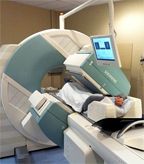Use of SPECT/CT in Melanoma Discovered More Sentinel Lymph Node Metastatic Involvement
Patients with node-negative melanoma undergoing sentinel lymph node excision who were given preoperative imaging with SPECT/CT experienced a higher frequency of metastatic involvement and a longer disease-free survival compared to those without preoperative SPECT/CT.
Patients with node-negative melanoma undergoing sentinel lymph node excision who were given preoperative imaging with single-photon emission computed tomography/computed tomography-or SPECT/CT-experienced a higher frequency of metastatic involvement and a longer disease-free survival compared to those without preoperative SPECT/CT, according to the results of a prospective study.

Single-photon emission computed tomography machine in operation; source: Ytrottier, Wikimedia Commons
“Due to our results, sentinel lymph node excision using the SPECT/CT technique should be offered to all patients with melanoma who have node-negative stage I-II disease,” said Joachim Klode, MD, of the department of dermatology, venereology, and allergology at the University of Essen-Duisburg, Essen, Germany.
According to background information in the article, published in the Journal of the American Medical Association, sentinel lymph node excision (SLNE) is considered to be the most important diagnostic procedure for patients with melanoma. Unfortunately, the procedure currently has a high false negative rate. SPECT/CT is thought to offer physicians the preoperative possibility of determining the exact location and visualization of the sentinel lymph node.
In this study, Klode and colleagues sought to compare SLNE among patients with or without preoperative SPECT/CT. Using a melanoma patient database at the University Hospital Essen, the researchers identified 403 patients with node-negative melanoma who were eligible to undergo SLNE between March 2003 and April 2011. The 254 patients with melanoma evaluated between 2003 and October 2008 did not undergo SPECT; 149 patients evaluated between November 2008 and study end did.
Overall, the results of the study indicated that the use of SPECT/CT increased the ability of clinicians to identify positive sentinel lymph nodes. Those patients who underwent SPECT/CT had a higher number of sentinel lymph nodes detected than the control group (2.4 vs 1.87; 95% CI, 1.93–2.18; P < .001), and a higher number of positive sentinel lymph nodes detected (0.34 vs 0.21; 95% CI, 0.21–0.31; P = .04).
In addition, the use of SPECT/CT allowed for greater excision of sentinel lymph nodes in the head and neck (23.5% vs 2%; 95% CI, 14.1%–28.2%; P < .001), as well as an increased identification of sentinel lymph nodes in overweight patients (25% vs 9.1%; P <.001) compared with patients in the control group.
Patients who underwent SPECT/CT also experienced a 6.8% local relapse rate compared with a 23.8% rate among patients who did not undergo imaging. This reduced relapse rate conferred a longer 4-year disease-free survival in the SPECT/CT group as well (93.9% vs 79.2%; P = .02).
According to the researchers, these results “demonstrate clear advantages of adding the described preoperative sentinel lymph node imaging by SPECT/CT to the current practice of preoperative lymphoscintigraphy in patients with melanoma.”
Klode added that additional merits of SPECT/CT include the ability to offer all patients SLNE with local anesthesia.
“This includes sparing patients the common risks and adverse effects of general anesthesia, such as nausea, vomiting, dizziness, and lethargy, and further minimizing the risks of aspiration pneumonitis and adverse effects of tracheal intubation, such as sore throat, croup, and hoarseness,” Klode said.